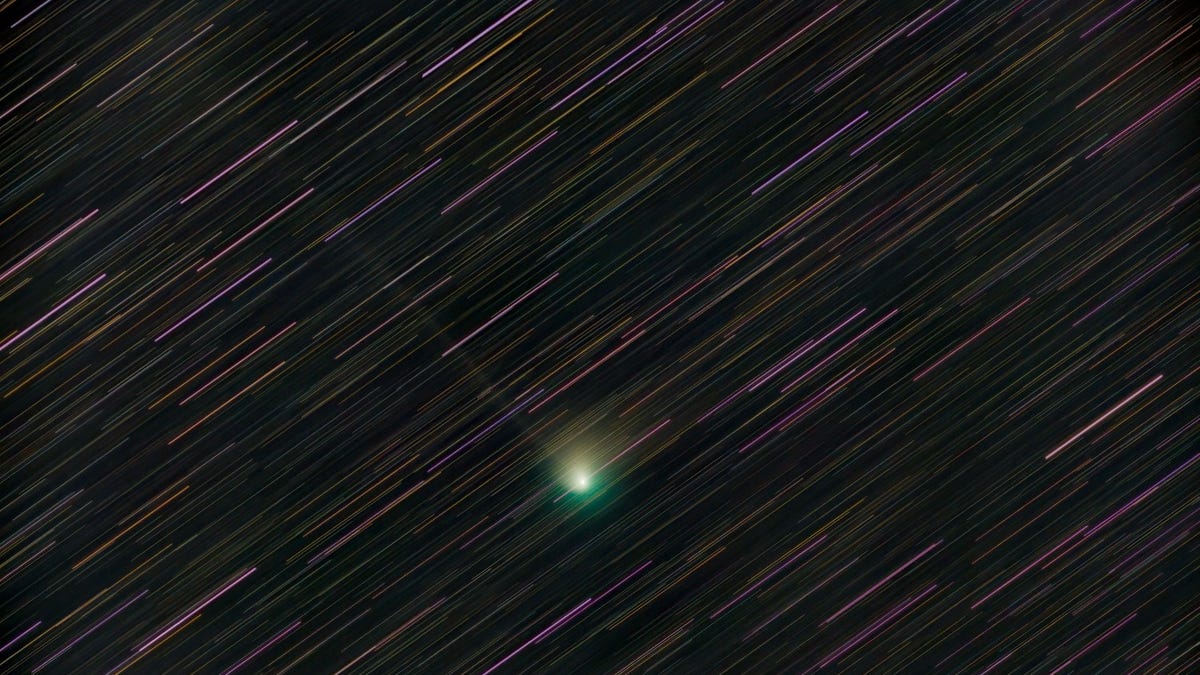Bright Green Comet Dazzles as It Passes Earth on 50,000-Year Journey
The comet, expected to be the brightest of 2023, has been seen sporting a rare "anti-tail."

Comet C/2022 E3 ZTF on Feb. 1.
Now's the time to look for Comet C/2022 E3 (ZTF) as it puts on a show while leaving Earth in its rearview.
The Zwicky Transient Facility, aka ZTF, in Southern California discovered the dramatic object in March. It had been speeding in the direction of the sun up until Jan. 12, when it reached perihelion, its closest pass by the sun, before beginning a long journey back to the Oort Cloud on the edge of the solar system.
According to Joe Rao from both Space.com and New York's Hayden Planetarium, it won't return for roughly 50,000 years. This makes now the prime time to try to see it for yourself.
NASA says it should be visible from dark locations with minimal light pollution.
A green comet will be closer to our planet today, Feb 2, than it's been in over 50,000 years! The brightness of comets is unpredictable, but with clear skies, you could see Comet C/2022 E3 (ZTF)!https://t.co/Isqg1V1LZG pic.twitter.com/bwdFZXpTK8
— NASA Goddard (@NASAGoddard) February 2, 2023
The space agency says the comet is expected to be closest to Earth on Thursday as a magnitude five object, just bright enough to see with the unaided eye, though binoculars and very dark skies always help.
Even as ZTF continues to speed back out toward deeper space, it may still be visible for a few more nights or longer.
Attached is a composition of the evolution of comet C/2022 E3.
— Con Stoitsis (@vivstoitsis) January 5, 2023
I have labeled the days, distance from the Sun and distance from Earth. Courtesy Didac Mesa Romeu. pic.twitter.com/fzq4AAMLJe
The behavior of comets is rather unpredictable, as they can brighten, dim or completely disintegrate with little warning. Comet ZTF's coma, or tail, has already been observed appearing to split into two distinct tails in what astronomers call a "disconnection event."
Amazing. Here's a great animated capture of Comet C/2022 E3 ZTF's recent tail disconnection event (along with lots of #Starlink streaks), courtesy of @Komet123Jager - https://t.co/VWeFpDf4U2 pic.twitter.com/EP6lY9kg9s
— Dave Dickinson (@Astroguyz) January 19, 2023
It's also been seen sporting a so-called "anti-tail," which is actually an optical illusion that makes the comet appear to have a tail on both sides of its nucleus.
My take on the "green comet" — #Comet C/2022 E3 (ZTF), on the night of Jan 22/23, 2023, with it showing a strong anti-tail spike. Taken with just 250mm focal length for a field similar to binoculars. It was easy in binos but barely naked eye from a dark site. @SkyNewsMagazine pic.twitter.com/fE7Qs6yE8Y
— Alan Dyer (@amazingskyguy) January 23, 2023
You can practice trying to spot the comet now with binoculars or a backyard telescope as it continues to (hopefully) brighten. By far the easiest way to locate it is with a site like In The Sky or the excellent mobile app Stellarium.
If you happen to get any great photos, please share them with me on Twitter, @EricCMack.

